| Columns Retired Columns & Blogs |
Something that competes with the Revel Salon 2, Price and performance wise
Because of the Magico A5's bulk and weight, I drove my test gear to Jim Austin's apartment to perform the measurements in situ. As always, I used DRA Labs' MLSSA system, an Earthworks microphone preamplifier, and a calibrated DPA 4006 microphone to measure the Magico A5's behavior in the farfield. (We maneuvered one of the 180lb speakers, serial number 000407, onto a dolly and rolled it so it fired across a room diagonal and was maximally distant from the sidewalls.) I used an Earthworks QTC-40 mike for the nearfield and spatially averaged in-room responses. (For the latter, the loudspeakers were in the positions where JCA had auditioned them.)
Magico specifies the A5's sensitivity as 88dB for 2.83V at 1m. My estimate was slightly lower, at 86.5dB(B)/2.83V/m. The A5's impedance is specified as 4 ohms. Using Dayton Audio's DATS V2 system, I found that the impedance magnitude (fig.1, solid trace) did average around 4 ohms, with a minimum value of 2.6 ohms at 93Hz. The electrical phase angle (dashed trace) is occasionally high when the magnitude is low. For example, there is a combination of 3.4 ohms and –50° at 70Hz, a frequency where music can have high levels of energy. The EPDR 1 drops below 2 ohms between 53Hz and 120Hz, with a minimum value of 1 ohm at 70Hz. The A5 must be used with amplifiers that don't have problems driving 2 ohm loads.
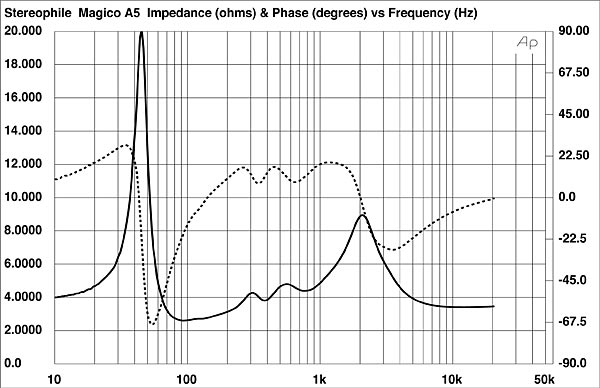
The traces in fig.1 are free from the small discontinuities that would imply that there are resonances of some kind present. When I investigated the enclosure's vibrational behavior with a plastic-tape accelerometer, I did find some resonant modes on the sidewalls and top panel, at 422Hz and 547Hz (fig.2), but these are at such low levels that they will not have any audible consequences.
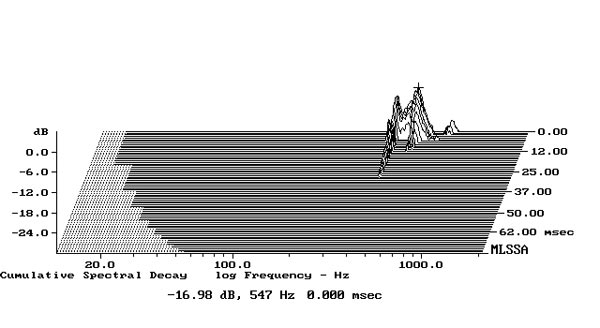
The single peak centered on 45Hz in the impedance magnitude trace suggests that this is the sealed-box tuning frequency of the woofers, which corresponds to the frequency where the anechoic response is down by 6dB. While their summed nearfield output (fig.3, red trace; the three woofers appear to behave identically) peaks a little higher in frequency than the tuning frequency, the excess of energy between 200Hz and 50Hz will be an artifact of the nearfield measurement. (This assumes that the radiators are mounted in a true infinite baffle, ie, one that extends to infinity in both planes.) The woofers' upper-frequency rolloff is clean, before crossing over to the midrange unit around 300Hz with symmetrical high-order slopes.
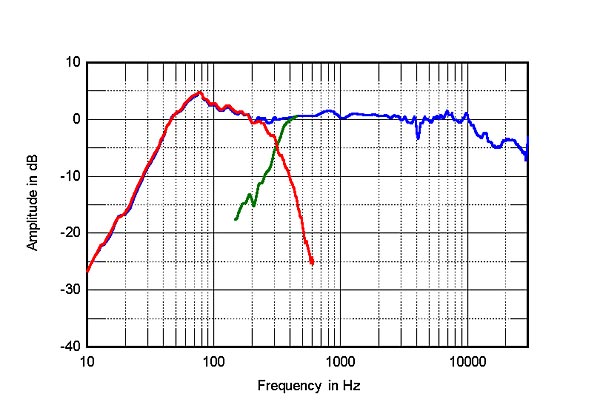
The blue trace below 420Hz in fig.3 is the complex sum of the nearfield midrange and woofer responses. Above 420Hz, the blue trace in fig.3 shows the A5's farfield response, averaged across a 30° horizontal window centered on the tweeter axis. Other than a very narrow suckout at 4kHz that will be very difficult to hear (footnote 2), the response is superbly flat and even up to 10kHz. The gentle downward slope above that frequency might have contributed to my estimate of the loudspeaker's sensitivity being slightly lower than the specification. As with the Magico M2 that I reviewed in February 2020 and JCA reviewed in March 2021, the use of a pistonic tweeter with a high-Q ultrasonic dome response results in a lack of energy in the region below that resonance.
Fig.4 shows the A5's horizontal dispersion, normalized to the response on the tweeter axis, which thus appears as a straight line. (The physical limitations of performing the measurements in JCA's room restricted the off-axis measurements to 45° to the sides rather than my usual 90°.) The loudspeaker's radiation pattern is smooth and even, though with a slight excess of energy to the sides in the presence region and a slight lack of energy off-axis above that region. The tweeter doesn't become as directional in its top audio octave as I was anticipating from my measurements of the M2.
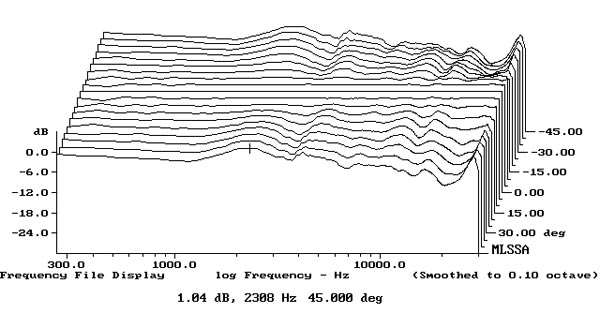
Fig.5 shows the Magico's vertical dispersion, again normalized to the response on the tweeter axis, which is 41" from the floor. Usefully, the response 5° below the tweeter axis, which will be close to JCA's listening axis, is similar to the tweeter-axis response. The usual off-axis suckout in the crossover between the midrange unit and tweeter doesn't make its presence known until 10° above the tweeter axis. Don't listen to this speaker while standing.
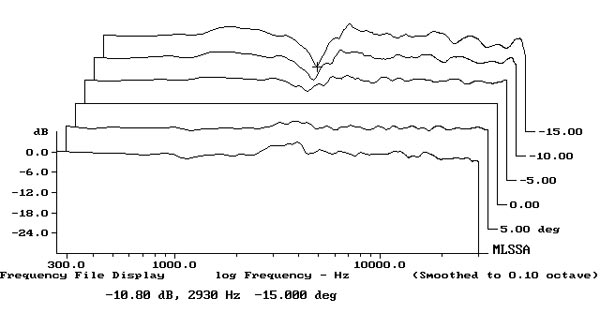
Fig.6 shows the Magico A5s' 1/10 octave-smoothed, spatially averaged response in Jim Austin's room. (The spatial averaging (footnote 3) tends to average out the peaks and dips below 400Hz that are due to the room's resonant modes.) I have not shown the in-room response below 45Hz, as this was affected by the presence of subsonic noise from his building's heating/ ventilation system. This could not be turned off on the morning that I was able to perform the measurements (footnote 4). The noise did not affect the farfield and nearfield measurements shown in figs.3–5, which were made with windowed impulse responses, but did affect the power spectra I measured to create fig.6.
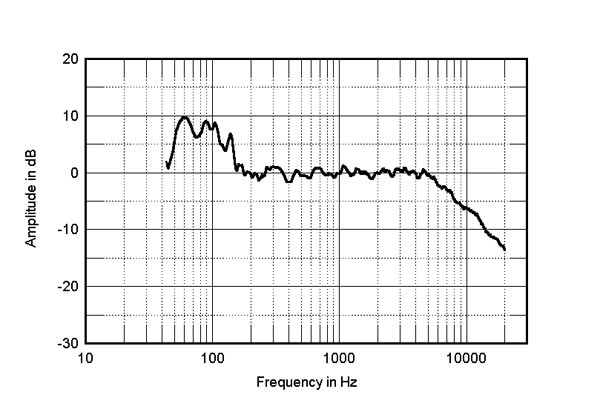
Other than an excess of energy in-room between 45Hz and 150Hz, which I suspect will be due to the Magicos exciting the low-frequency modes in JCA's room, the balance at the listening position is impressively even, meeting ±1.4dB limits between 180Hz and 5kHz. I can't recall measuring an in-room response this good! The A5s' output in the top two octaves smoothly slopes down, but as I have written before, a loudspeaker that offers a flat on-axis response and well-controlled lateral dispersion does give a gently sloped-down treble in the spatially averaged room response. This is primarily due to the increased absorption of the room's furnishings and the contribution from the loudspeaker's power response. (A speaker that has a flat measured top-octave output in an in-room measurement will sound as if the highs are tilted up.)
In the time domain, the A5's step response on the tweeter axis (fig.7) reveals that the tweeter, midrange unit, and woofers are all connected in positive acoustic polarity. The decay of the tweeter's step smoothly blends with the positive-going start of the midrange unit's step, and the decay of the midrange unit's step blends smoothly with the positive-going start of the woofers' step. This implies optimal implementation of the crossover. (The apparent DC offset in this graph is due to the fact that calculating the loudspeaker's step response from the measured impulse response integrates the subsonic noise.) Other than a narrow ridge of delayed energy at the frequency of the narrow suckout in the farfield response, the A5's cumulative spectral-decay plot (fig.8) is clean.
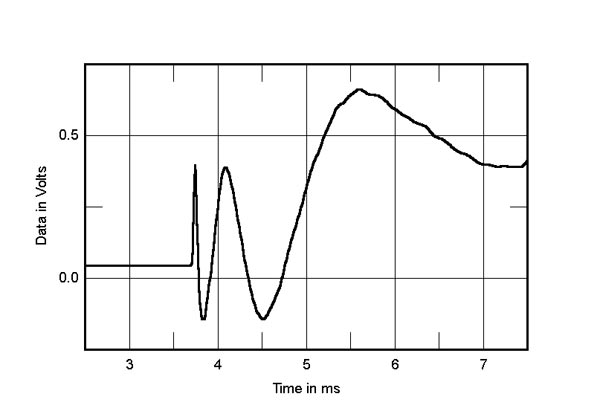
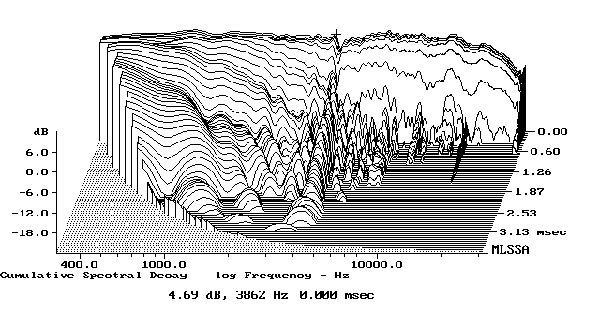
As with the other Magico loudspeakers that have been reviewed in Stereophile, the A5's measured performance indicates excellent audio engineering.—John Atkinson
Footnote 2: Unlike Magico's M2, which has a baffle with smoothly rounded edges, the A5 has a sharp-edged baffle. This will result in reflections from the tweeter's output that will interfere destructively with the output when the distance between the tweeter and the edges is an odd number of half wavelengths. The wavelength at 4kHz is 3.4" and the distance between the center of the tweeter dome and the edges of the baffle to its sides is 5.25", ie, very close to three half wavelengths at this frequency.
Footnote 3: Using MLSSA, I averaged 20 1/10-octave–smoothed power spectra, individually taken for the left and right speakers, in a rectangular grid 36" wide by 18" high and centered on the positions of Jim Austin's ears.
Footnote 4: The subsonic noise from the system's intermittent fan, while not high in level, is loud enough to render serious, analytical listening difficult or impossible. The fan operates for hours at a time during the coldest weather but far less when it's warmer. It's turned off completely between early May and late October. JA's measurements were performed on a cold morning at the end of March.—Jim Austin

Something that competes with the Revel Salon 2, Price and performance wise

... the $25000 Magico A5 versus that of the $1200 Wharfedale Linton Heritage whose frequency response was described by JA1 as being "superbly flat"?
https://www.stereophile.com/content/wharfedale-linton-heritage-loudspeaker-measurements

Looking at the specs, and as JA points out, these speakers require an amp that doesn’t have a problem driving a 2ohm load! How many amps have no problem driving a 2ohm load??

... rated output of 400W/ch into a 2 ohm load.
https://parasound.com/2250-v2.php
Price is a mere $999.
https://www.audioadvisor.com/prodinfo.asp?number=PAC2250V2

The Parasound amps in their more expensive lines (above your example) would be also work in those 4-2 ohm loads, and be a much better match sonically and power-wise.
At this speaker's price point, there are a ton of amp choices that would work fine... more so in that point of the market than on the mid-level or entry-level end. It's part and parcel to moving up in many areas of performance, and should be a no-brainer here.

Parasound amps don't like running below 4 ohm ( JC-1’s no problem ) much , it would not be my choice for this Magico model Speakers ...!
Regards

... capable of 900W into a 2 ohm load.
Need more?
According to a Hi-Fi News test, the JC5 is capable of 1680W into a 2 ohm load.

Safe to say that most every tube amp out there would be excluded. Why these speakers have such a brutal low impedance drop is really the question?

... have 2 ohm taps on the output transformer.
The MC1502 can output 240W/ch into a 2 ohm load at 1% distortion.

I had noticed the mention of titanium voice-coils in the magazine article, so I checked Magico's marketing web page and confirmed that also mentions titanium voice-coils. I suspect that might be an error, and was waiting for the article to appear here to comment on that.
The voice-coil and voice-coil former/bobbin are two different things serving two different purposes. The voice-coil is a wound coil of electrical wire. The voice-coil former/bobbin is the structural tube that the voice-coil is wound around and structurally connects to the diphragm and to the suspension spider. The structural voice-coil former/bobbin might be made of titanium, but the voice-coil very probably is not wound using titanium wire since titanium is a relatively poor electrical conductor relative to copper which is commonly (but not always) used in voice-coils.

Punchy on bass region, but doesn't go deep on the sub bass region (~40hz is the best?), I have expected more for 3 x 9" woofers. The 2-ohm requirement and 86db sensitivity would make anyone want to buy these speakers spend more money to make the speaker 'sing' effortlessly. Revel Salon 2 is better in term of performance/measurement, but it has been discontinued.

"I have not shown the in-room response below 45Hz, as this was affected by the presence of subsonic noise from his building's heating/ ventilation system. This could not be turned off on the morning that I was able to perform the measurements"
The Salon 2 is still available..
https://www.revelspeakers.com/products/types/floorstanding/Salon2-.html

Many rush to judgment without even hearing them, let alone trusting the professional.

Its 86db with 2 watts , so actually its only 83db with 1 watt , so think of using 300 watts/ch to get the best out of these ....!
Regards

….and can heartily concur with this review. Had Q3’s in the past and these wonderful speakers easily exceed those worthy speakers. Extraordinary fidelity at low levels but can do “concert” levels if the house or neighbours allow.
Added the SPods as a measure of safety as we now live in a condo.

I cannot think of excellent audio engineering of a speaker with an impedance as low as this one. Considered that the phase angels are pretty mean in the bass region, where enrgy in music often is high, doesn´t make things better.
And then the massive amount of delayed sound on the waterfall plot?
What makes this loudspeaker excellent engineering?
The waterfall plot should actually mirror the stiffness of the cabinet, but it doesn´t at all.
To me a reasonable impedance combined with a reasonably uncorrected linear progress, will make almost any amplifier perform better, and a clean waterfall plot is paramount for transparancy in speakers.
It seems like none of these qualities are found in this speaker.

I assume it’s mass must store the energy and release it slowly , has always been an issue with mass loading it stores energy, part of the reason some speaker manufacturers prefer light mass construction
Having heard these , they are very impressive for the money when I heard them, in fact I thought they must be more expensive than they are
Being a sealed design, they drop off slower than ported designs per octave, and will have generally less room interactions, the fact they got 20 hertz in room audible, a feat in itself given the relative loudness is much lower at this frequency, unless they were hearing the second harmonic ?
Pass amplifiers seem to work very well with Magico, but would have been interesting to have tried with the Gryphon essence which are a scale above the Pass in my experience

I wasn't hearing 40Hz. In fact, that's a pretty hard mistake to make listening to descending warble tones.
Jim Austin, Editor
Stereophile

Indeed! Most modern amps will have no issue. We use Pass X150.8 to driver these beauties. These are not much different then most other speakers reviewed here lately (Focal, Wilson etc.)

Are you kidding? Where are the highs above 10Khz?!

.. The less important the last octave becomes, and on top of that, The teenagers who can hear the last octave can't afford them, so...
But still, from an engineering standpoint, I agree.

"As with the Magico M2 that I reviewed in February 2020 and JCA reviewed in March 2021, the use of a pistonic tweeter with a high-Q ultrasonic dome response results in a lack of energy in the region below that resonance.

..that are extremely linear well beyond 20khz, let alone 10khz, but I've never seen one this linear below 12khz.

I would suspect that this speaker would be a total no no for any tube amp out there. Pity that a lot of competent speakers these days are such a bear to drive, requiring a significant outlay to not only buy the speaker in question, but also the monster amps to drive them!

…is what Jim Austin didn’t mention at at all: how the A5 compares to the M2 he just spent a year with, and which cost 2.5x as much. Given how much audio writers tend to emphasize that the more expensive sibling really is worth it, even when praising a low priced overachiever, JA2’s silence on this point says it all. The A5 either betters the M2, or equals it.
To me it’s still completely academic, I will never buy speakers this expensive, but if I did have 24K to put into speakers, this one would be on my list to audition.